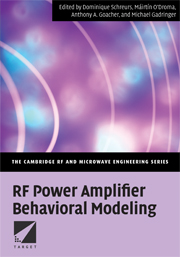Book contents
- Frontmatter
- Contents
- Notation
- Abbreviations
- Preface
- 1 Overview of power amplifier modelling
- 2 Properties of behavioural models
- 3 Memoryless nonlinear models
- 4 Nonlinear models with linear memory
- 5 Nonlinear models with nonlinear memory
- 6 Validation and comparison of PA models
- 7 Aspects of system simulation
- Appendix A Recent wireless standards
- Appendix B Authors and contributors
- Index
1 - Overview of power amplifier modelling
Published online by Cambridge University Press: 06 January 2010
- Frontmatter
- Contents
- Notation
- Abbreviations
- Preface
- 1 Overview of power amplifier modelling
- 2 Properties of behavioural models
- 3 Memoryless nonlinear models
- 4 Nonlinear models with linear memory
- 5 Nonlinear models with nonlinear memory
- 6 Validation and comparison of PA models
- 7 Aspects of system simulation
- Appendix A Recent wireless standards
- Appendix B Authors and contributors
- Index
Summary
Introduction
This chapter presents an overview and comparative assessment of the various approaches to RF power amplifier (PA) modelling that have received widespread attention by the scientific community. The chapter is organised into three sections: power amplifier modelling basics, system-level power amplifier models and circuitlevel power amplifier models.
Section 1.2 on power amplifier modelling basics provides the basic knowledge to support the subsequent PA model classification and analysis. First, physical and behavioural modelling strategies are addressed and then behavioural models are classified as either static or dynamic with varying levels of complexity. Then, a distinction is made between the heuristic and systematic approaches, hence creating a theoretical framework for comparing different behavioural model formats with respect to their formulation, extraction and, in most cases, predictive capabilities.
In Section 1.3, dedicated to system-level power amplifier models, PA representations intended to be used in system-level simulators are considered. These are analytic signal- or complex-envelope-based techniques; they do not represent the RF carrier directly and RF effects are not specifically included. They are single-input–single-output (SISO) low-pass equivalent models, whose input and output constitute the complex functions needed to represent the bidimensional nature of amplitude and phase modulation.
The final section, on circuit-level power amplifier models, provides an overview of behavioural models intended for use in conventional PA circuit simulators. These models handle the complete input and output RF modulated signals, which are real entities, at two different time scales, one, very fast, for the RF carrier and another, much slower, for the modulating envelope.
- Type
- Chapter
- Information
- RF Power Amplifier Behavioral Modeling , pp. 1 - 26Publisher: Cambridge University PressPrint publication year: 2008

